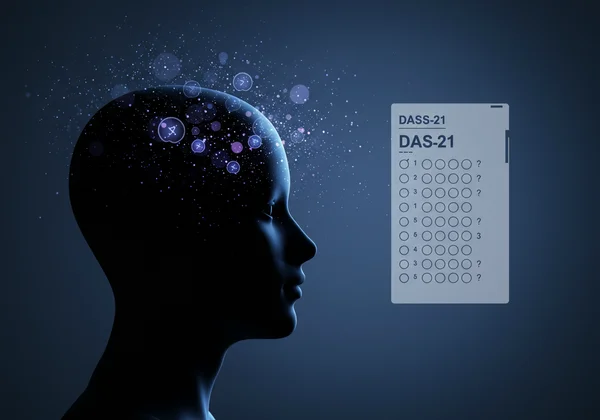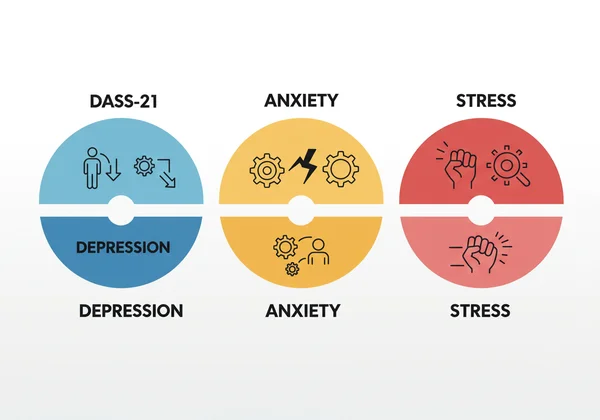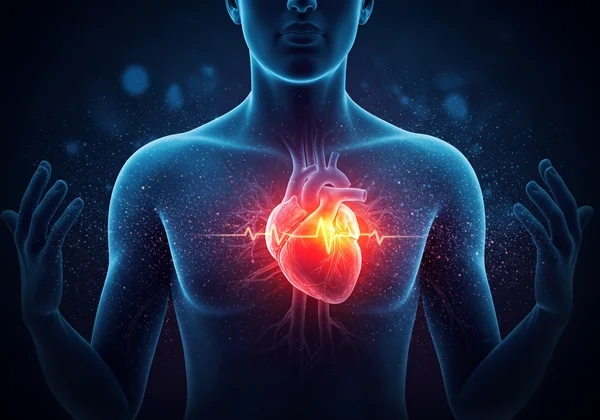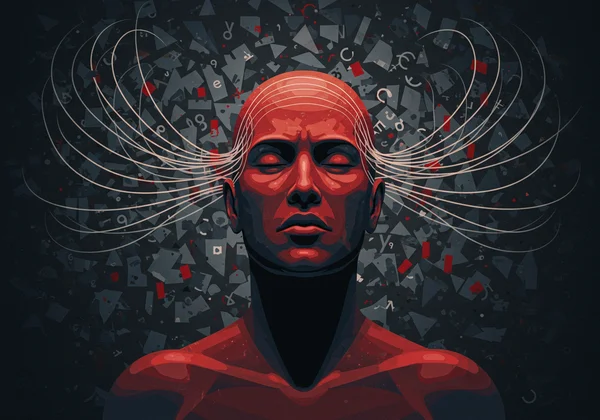DASS-21 问题详解:每个项目衡量什么
你是否曾审视一份自我评估问卷,并好奇每个问题 真正 在问什么?抑郁、焦虑和压力量表(DASS-21)是一个强大的自我反思工具,但只有当你理解其 21 个问题背后的目的时,才能解锁其真正的价值。本指南将详细解读 DASS-21 问题,透明地审视这份评估如何描绘你的情绪状态。 好奇你的 DASS-21 分数真正揭示了什么吗?让我们逐一分析每个问题。
DASS-21 不仅仅是一系列随机的问题;它是一个精心设计的工具,旨在帮助你了解过去一周的情绪状态。通过对其进行分解,你可以更深入地理解自己的回答及其可能意味着什么。在我们深入探讨具体细节之前,如果你准备好亲身体验这些问题,随时可以在我们的主页上 进行免费评估。

DASS-21 量表解读:三大核心分量表
DASS-21 的巧妙之处在于其结构。它将常常混杂在一起的负面情绪分为三个不同的类别,即分量表:抑郁、焦虑和压力。每个分量表包含七个具体问题,旨在衡量该特定状态的核心症状。这种区分使得对你的情绪健康有更细致的理解。
虽然这些状态感觉相似且经常重叠,但 DASS-21 有助于阐明你的挑战可能在哪里。例如,你可能普遍感觉“不好”,但该测试可以帮助你识别这种感觉是更多地源于绝望(抑郁)、身体恐慌(焦虑)还是持续的紧张(压力)。
抑郁、焦虑和压力:区分差异
要真正理解 DASS-21 提供的洞察,了解它所衡量的关键差异会很有帮助。 抑郁分量表 侧重于情绪低落、绝望以及对生活缺乏兴趣或乐趣等症状。 焦虑分量表 则着重于生理唤醒、恐慌和持续的担忧。最后, 压力量表 衡量的是不知所措、易怒和无法放松的感觉。掌握这些区别对于有效解读你的结果至关重要。

抑郁分量表:解读悲伤、绝望和动力不足的感觉
本部分的七个问题旨在衡量你与抑郁相关症状的体验。这不仅仅是关于感到悲伤;它更广泛地衡量了积极情感的缺乏、无价值感以及对生活缺乏精力或热情。如果你觉得很难获得动力或难以从过去喜欢的事物中找到乐趣,这些问题会引起你的共鸣。
这些项目探讨了抑郁状态的认知和情感组成部分。它们评估你如何看待自己、你的生活和你的未来。如实回答它们,可以清晰地反映这些感受最近对你产生了多大影响。
问题 3, 5, 10, 13, 16, 17, 21:抑郁状态的指标
专门针对抑郁症的七个项目——问题 3, 5, 10, 13, 16, 17 和 21——是 抑郁状态的核心指标。它们探讨的主题包括:
- 快感缺乏: 无法体验快乐或兴奋。
- 绝望感: 感觉未来黯淡无光,事情不会好转。
- 对生活失去价值感: 感觉生活失去了意义或价值。
- 自尊心低: 感到自己一无是处或像个失败者。
- 缺乏主动性: 发现难以开始任务或行动。
- 惰性: 普遍缺乏精力与热情。
通过检查这些具体领域,DASS-21 全面审视了定义抑郁状态的症状,远不止简单的悲伤。
焦虑分量表:探究恐慌、恐惧和生理唤醒
焦虑分量表将焦点转向你身体的生理反应以及你主观的恐惧感。这七个问题旨在检测生理唤醒的存在——例如心跳加速、手颤抖或呼吸急促等症状。它们还评估情境性焦虑以及持续的紧张不安感。
DASS-21 评估 的这一部分在识别焦虑的身体表现方面特别有效,这些表现常常被忽视。它帮助你将情感上感受到的(恐惧、担忧)与身体上体验到的联系起来。如果你准备好探索这些联系,现在就 开始你的 DASS-21 测试 吧。

问题 2, 4, 7, 9, 15, 19, 20:识别焦虑症状
针对焦虑的项目——问题 2, 4, 7, 9, 15, 19 和 20——是 识别焦虑症状 的关键。这些问题询问与以下方面相关的体验:
- 自主神经唤醒: 身体症状,如口干或呼吸困难。
- 骨骼肌影响: 经历颤抖或摇晃。
- 情境性焦虑: 对特定情境感到担忧或恐慌。
- 主观恐惧体验: 探究恐慌、害怕失控或害怕死亡的感觉。
这些问题有助于确定你日常生活中“战斗或逃跑”反应的强度,从而清晰地衡量你的焦虑水平。
压力量表:应对紧张、易怒和放松困难
DASS-21 的最后七个问题针对的是压力体验。该分量表衡量的是持续紧张、难以放松、易怒以及容易激动或心烦意乱的状态。它反映了较低的挫折容忍度以及持续处于紧张和不知所措的感觉。
与侧重于恐慌和恐惧的焦虑量表不同,压力量表着重于慢性过度兴奋和神经紧张的状态。它关乎感到紧绷、不耐烦和无法放松。这些是长期承受压力的典型迹象,DASS-21 在衡量其严重程度方面表现出色。

问题 1, 6, 8, 11, 12, 14, 18:理解压力反应
针对压力的七个问题——1, 6, 8, 11, 12, 14 和 18——有助于 理解压力反应。它们涵盖的模式包括:
- 放松困难: 无法放松身心或感到自在。
- 焦躁不安: 一种焦躁不安、神经紧张的感觉。
- 易怒: 容易感到烦躁、激动或暴躁。
- 过度反应: 对轻微挫折或问题反应强烈。
- 不耐烦: 发现难以忍受延迟或中断。
这些项目共同描绘了压力对你应对日常生活能力的影响程度。识别这些反应是管理它们的关键第一步。
超越问题:解读你的 DASS-21 分数及后续步骤
一旦你在 保密 DASS-21 工具 上完成 21 个问题,你的答案不会被束之高阁。每个回答都被赋予一个数值,这些数值会针对抑郁、焦虑和压力这三个分量表分别汇总。这个过程会给你三个独立的分数,然后将这些分数与从正常到极度严重的严重程度量表进行比较。
这种评分系统将你的主观感受转化为客观数据,提供了你情绪健康的清晰即时快照。它帮助你了解哪些领域可能需要你的关注。
你的回答如何转化为可操作的见解
了解你的分数会让你感到更有力量。它不是一个标签或诊断,而是自我意识和行动的起点。你的结果将成为 可操作的见解,可以指导你的下一步。例如,高压力分数可能会促使你探索放松技巧,而中度抑郁分数可能是一个信号,表明你需要重新投入爱好和寻求社会支持。目标是利用这些信息做出积极的改变。何不 获取你的分数 并开始你的旅程?
掌控:使用 DASS-21 的下一步
理解 DASS-21 中每个问题背后的“为什么”,能将其从一个简单的测试转变为一个深刻的自我发现工具。通过了解这份评估仔细衡量了抑郁、焦虑和压力的不同症状,你可以更自信地对待它,并从结果中获得更深刻的见解。这些知识使你能够掌控自己的心理健康之旅。
请记住,DASS-21 是一个筛查工具,而非诊断工具。它是理解的第一步,是一个为你指明方向的指南针。这个过程中最重要的是你如何利用这些信息。
准备好应用这些知识了吗?在 DASS-21 官方评估平台 进行免费、保密且即时的 DASS-21 评估,获取你的个性化分数,今天就开始你的更高自我意识之路。
关于 DASS-21 评估的常见问题
什么是 DASS-21 测试,它衡量什么?
DASS-21 是一种广泛使用且经过科学验证的自我报告问卷,旨在衡量三种负面情绪状态的严重程度:抑郁、焦虑和压力。它包含 21 个问题,你需要在其中评估每个陈述在过去一周内对你的适用程度。它提供了一种快速可靠的方式来检查你的情绪健康状况。
DASS-21 各分量表分数如何计算?
评分方法很简单。对于每个分量表(抑郁、焦虑和压力),将七个相关问题的分数相加。由于 DASS-21 是原始 DASS-42 的缩写形式,这些总分随后乘以二,使其与完整量表具有可比性。最终分数将你置于每个类别的严重程度谱系中,从正常到极度严重。你可以通过使用 我们的在线 DASS-21 测试 工具来了解其运作方式。
DASS-21 是精神健康状况的诊断工具吗?
不,这是一个关键点。DASS-21 是一种筛查工具,而非诊断工具。它可以指示与抑郁、焦虑和压力相关的症状的存在和严重程度,但它不能诊断临床疾病,如重度抑郁症或广泛性焦虑症。要获得正式诊断,你必须咨询合格的医疗专业人员。
谁可以从 DASS-21 评估中受益?
几乎所有人都可以受益!它对于希望监测自身情绪健康的“自我关怀者”、面临学业和社会压力的学生,甚至希望了解自身压力水平的专业人士都特别有用。对于任何寻求快速、私密且富有洞察力的情绪健康检查的人来说,它都是一个有价值的工具。
DASS-21 测试是免费且保密的吗?
是的,在我们的平台上, DASS-21 评估 完全免费且保密。我们致力于保护你的隐私。你无需注册,你的回答和结果都将匿名保存。这使你能够在安全可靠的环境中探索自己的情绪状态。准备好开始了吗? 今天就试试这个测试 吧。